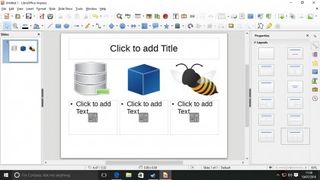

Other picture recoloring does not have an equivalent and is flattened. Some picture recoloring has the equivalent in ODF, such as black and white. Styles that are not supported are saved as the default, black solid line and open arrow type, respectively.Ĭropping a picture with a shape is not supported. Not all line and line end styles are supported in ODF. Gradient fills with more than two stops lose all stops after the first two. Supported except for slide background fill. Unsupported styles are saved as the default border style (black, solid line). The ink annotation is converted to an Enhanced Metafile (EMF) image. Some object types are supported, but they aren't all supported. Supported except for the insert and link option which are not supported by ODF. Text and base text color are kept, but WordArt effects and formatting are lost. Objects inside text boxes are dropped when you open an OpenDocument file. The table below shows which PowerPoint graphics features are supported, partially supported, or not supported in the OpenDocument Format (.odp). Overflow might be seen differently in different ODF applications. Text can't have outlines different from the fill color. Text with picture, gradient, pattern, or empty filled outlines. Picture filled, gradient filled, pattern filled, or empty filled text. Italics, bold, underline, and strikethrough are all supported in ODF applications. Other ODF applications might change the numbering/bulleting or not support it all together. Regular hyperlinks are supported, but on-hover hyperlinks are not supported.

Some visual differences might be seen in the alignment, anchoring, or wrapping of the text in other ODF applications.Ģ70-rotation and stacked text are not supported. Some international numbering systems are mapped to bullets or Western numbering Theme information is lost from placeholders. Layouts are treated similar to masters when opened in other ODF applications. However, it does cause all future edits to be done as if that default theme was applied. odp format, the default theme is used, but should not cause any changes in the presentation. When you open the presentation after saving the presentation in. Fonts, colors, and effects on new shapes are no longer inherited. Theme information is lost and placed onto the masters/layouts. The dialog box tries to default to the default page size. Similarly, date and time types from other ODF applications may be converted to a default type by PowerPoint.Īlthough the page size is saved with the presentation, the Page Size settings in the Page Setup dialog box is inaccurate. odp format, the headers and footers become text boxes.Īll date and time types are included, but they might be converted to a default type by other ODF applications. When you save a file with headers or footers in it in the. odp format become images and can't be edited further. odp format may not be rendered in the same way by other ODF applications, but will remain tables. In PowerPoint 2013 and newer versions, tables saved in the. The following transitions are not supported: Blinds, Cut, Strips, Comb, and Newsflash. If you plan to save your presentation in an OpenDocument Format, don’t use these features.Īnimations that can't be supported by ODF are changed to an Appear or Disappear animation.īlast, Flash bulb, Grow & Shrink, Vertical Height animations are not supported.Īnimations on chart parts are converted to an animation on the whole chart. Not supported This feature isn't supported in OpenDocument format. No text or data is lost, but formatting and how you work with text or graphics might be different. Partially supported Both PowerPoint and the OpenDocument Presentation format support this feature, but formatting and usability might be affected. Content, formatting, and usability won’t be lost. Supported Both PowerPoint and the OpenDocument Presentation format support this feature. The table below shows which PowerPoint features are fully, partially, or not at all supported in the OpenDocument Presentation (.odp) format. This is because of the different features and options, such as formatting, that OpenDocument Presentation applications and PowerPoint support. When you open or save presentations in the OpenDocument Presentation (.odp) format, some formatting might be lost. This is because of the differences between applications that use the OpenDocument Format. Note: When you open an OpenDocument Presentation file in PowerPoint, it might not have the same formatting as it did in the original application it was created in.


 0 kommentar(er)
0 kommentar(er)
